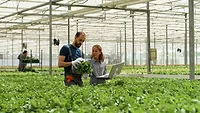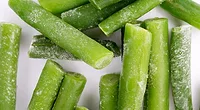Microbial Hazards of Microgreens Production, Indoor Farming

Credit: DamianH3 via Pixabay
A recent study conducted by researchers at the University of Arkansas (U of A) provides new insight into the microbial food safety risks of microgreens production. The project aimed to close the existing knowledge gaps about microgreens production and controlled environment agriculture, which is an area that the researchers say has not yet been characterized. The results point to microgreen variety and soil type as key factors in the crop’s illness-causing potential.
Microgreens, which are often confused with sprouts, are the “immature seedlings of edible plants,” according to the researchers. Microgreens differ from sprouts in that they grow for a longer period of time, allowing the plant to develop a second set of leaves. Additionally, unlike sprouts, microgreens have not yet been attributed to any recorded foodborne illness outbreaks, although there have been six to eight recalls of microgreens within the last three years due to possible Listeria monocytogenes or Salmonella contamination. The researchers assert that the recall history of microgreens indicates that the product—or the environment the product is grown in—can be contaminated with hazardous microbes.
While microgreens are not sprouts, they are also not quite leafy greens. A major difference between leafy greens and microgreens that lends to the latter’s susceptibility to foodborne pathogens is the environment in which microgreens are grown. Microgreens are typically farmed indoors, in soil alternatives such as hemp mats, peat with vermiculite, or other recycled plant materials.
The study examined virus persistence in pea shoots and sunflower microgreens, which are the most commonly grown varieties according to the results of a preliminary, nationwide survey. The researchers introduced the Tulane virus, a pathogen similar to human norovirus, to the various soil alternatives used in the study at different times during the 10-day growth cycle. The researchers also tested virus persistence on leaf surfaces through direct inoculation three days prior to harvest.
Regarding virus persistence in the soil alternatives, the results showed a significant decrease in viral count throughout the growth cycle, indicating a low level of risk for contamination of the final product or cross-contamination, given that initial viral loads are low. The researchers postulate that some aspect of the soil alternatives may neutralize the infectious nature of the virus.
However, the viruses showed persistence on the edible material after inoculation. The pea shoot samples retained approximately 50,000 more viruses per plant than the sunflower microgreens, which only had six viruses per plant.
The researchers, who suggest that indoor agriculture may provide a false sense of security regarding food safety, also discuss hygienic solutions to mitigating foodborne pathogen contamination in such environments. For instance, good agricultural practices and proper cleaning and sanitation measures must be maintained and tailored to the unique growing environment. Personal hygiene and responsible sourcing of seeds are also paramount. The researchers hope to provide food safety protocols that are specific to small-scale microgreen growers in the future.
The study was led by Kristen Gibson, Ph.D., a professor of food safety and microbiology for the Arkansas Agricultural Experiment Station—U of A’s research arm of the System Division of Agriculture—and the Director of the Center of Food Safety. Dr. Gibson’s future work may explore sanitizing products for use on edible tissue, testing other popular microgreen varieties and microorganisms, and the interaction between viruses and bacteria in different soil alternatives.
Looking for quick answers on food safety topics?
Try Ask FSM, our new smart AI search tool.
Ask FSM →









